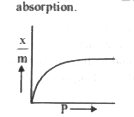The effect of pressure on adsorption is high if
a. Temperature is low
b. Temperature is high
c. Temperature is neither very low nor very high
temperature is low.
temperature is high
temperature is very high.
larger charcoal piece is taken
The correct Answer is:A
At low temperature, pressure have greater effect on absorption

Topper's Solved these Questions
- SURFACE CHEMISTRYBook:DISHA PUBLICATIONChapter:SURFACE CHEMISTRYExercise:Exercise-2 :Concept Applicator
Explore 30 Videos
- SURFACE CHEMISTRYBook:DISHA PUBLICATIONChapter:SURFACE CHEMISTRYExercise:Exercise-2 :Concept Applicator
Explore 30 Videos
- STRUCTURE OF ATOMBook:DISHA PUBLICATIONChapter:STRUCTURE OF ATOMExercise:Exercise
Explore 112 Videos
- THE D- AND F- BLOCK ELEMENTS Book:DISHA PUBLICATIONChapter:THE D- AND F- BLOCK ELEMENTS Exercise:EXERCISE - 2 CONCEPT APPLICATOR
Explore 30 Videos
Similar Questions
The effect of pressure on adsorption is high if
a. Temperature is low
b. Temperature is high
Temperature is neither very low nor very high
d. Charcoal piece is taken in place of charcoal powder
View SolutionWhich is correct in case of extent of physisorption
High temperature low pressure
low temperature high pressure
low temperature low pressure
All
View Solution
Knowledge Check
A device used to measure very high temperature is
APyrometerBThermometerCBolometerDCalorimeterDevice used measure very high temperature is
ApyrometerBthermometerCbolometerDcalorimeterSpecific heat of a metal at very low temperatures varies as
ATBT2CT3/2DT3
Real gases deviate from ideal behaviour at low temperature and high pressure.
View SolutionVernalization is the effect of low temperature on:
View SolutionWhich of the reaction is expectd to be spontaneous at low temperatures and non-spontaneous at high temperatures:
View SolutionAssertion An actual gas behaves as an ideal gas most closely at low pressure and high temperature.
Reason At low pressure and high temperature, real gases obey the gasl laws.
View SolutionHigh pressure and high temperature will be favourable conditions for a high equilibrium yield in the reaction
View Solution

